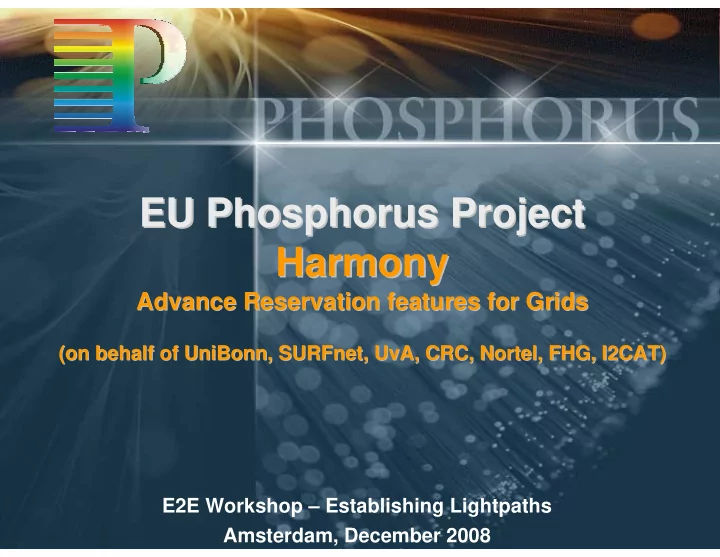

EU Phosphorus Phosphorus Project Project EU Harmony Harmony Advance Reservation Reservation features features for for Grids Grids Advance (on on behalf behalf of of UniBonn UniBonn, , SURFnet SURFnet, , UvA UvA, CRC, , CRC, Nortel Nortel, FHG, I2CAT) , FHG, I2CAT) ( E2E Workshop – Establishing Lightpaths Amsterdam, December 2008
Phosphorus Architecture HARMONY
Harmony system is… • An multi-domain path provisioning system where users and Grid applications can book in advance end-to-end paths with AA • The Harmony Service Interface (HSI) allows the user, Middleware or ever applications operate the whole inter-domain scenario • Harmony allows heterogeneous domain interoperability by performing an inter-domain resource brokering over the heterogeneous Network Resource Provisioning Systems (NRPS) underlying • NRPS considered are: • Argia Argia/UCLP /UCLP (CA-CRC/Inocybe, Spain-i2CAT) • • ARGON • ARGON (Germany –Viola Testbed) • DRAC DRAC (Holland- Nortel/SURFnet) •
Grid applications in Phosphorus WISDOM - Wide In Silico Docking On Malaria � WISDOM consists of virtual screening techniques AutoDock and FlexX. both are in silico docking techniques, where researchers use large computing power (Grid systems) to compute the probability that potential drugs will dock with a target protein. � Distribution of high volume input data from the specified Input data Server � High bandwidth need and low latency for data distribution of up to 240 GB KoDaVis –Making Atmospheric Processes visible � Simulations of physical and chemical processes in the atmosphere help to understand the effect of human activities on the climate: data sets ~ 1000 GigaByte stored on 1 or more central servers � Collaborative visualization of data provides insight into processes TOPS - Technology for Optical Pixel Streaming � Streaming of high resolution 2D scientific content � Huge data source (~50 TB), not practical to transfer data itself � Interactive queries on data source. Results (images) are streamed to scientist for analysis � Visualisation of huge data-sets on a tiled panel display (TPD). The rendering is performed at a source node � Requirements: 10 Gbit/s , 100 msec latency , layer 2, MTU 9000 � DDSS – Distributed Data Storage System � Huge data volumes moved over the network in parallel TCP/IP streams � Transfers both latency- and bandwidth-dependent � Single network links allocation for one-to-one scenarios
Harmony testbed
HARMONY HARMONY Architecture Architecture Key points: • Distributed (P2P) or Hierarchical architecture for the Network Service Plane (NSP) • The NSP is composed by independent entities ( Inter Domain Brokers ) • Harmony Service Interface common for the adaptation layer and the network service plane
Harmony Service Interface – HSI
Harmony AAI – Overview � The Harmony System implements an Authentication (AuthN) and Authorisation (AuthZ) Infrastructure based on the Generalised AAA Toolkit [1]. � AuthN • Based on user certificate + user signature. • PKI-based, using certificate X.509. • Signature is exchanged using SAML assertions among entities. • Signature added as part of the SOAP header in the service request message. � AuthZ • Access control based on XACML obligations using local policy databases. • Implemented using GAAA-Toolkit (ver. 0.5). • Session is kept exchanging tokens among entities (token := GRI, value, validity) [1] http://staff.science.uva.nl/~demch/projects/aaauthreach
Advance Reservation Algorithm bandwidth bandwidth • Malleable reservations stand behind the user intention for transfering a certain amount of data within a given deadline. • When a reservation request is received, the IDB loops over different interdomain paths, possible start times and bandwidths (inside user’s constraints range) to find a set of available resources that fulfill the request. time time • The steps followed by the IDB are: earliest start earliest start deadline deadline time time 1. Path computation and choice of bandwidth – In a first step, a path between the given user endpoints is computed. Then, only bandwidths in the range requested are chosen. 2. Bandwidth adaptation – The attempt here is made to adjust all the endpoints on the given path to a common bandwidth level. First, it chooses the min-max bandwidth following user’s constratins. In the second step, the highest bandwidths are reduced according to the technology-induced granularity until the smallest bandwidth is equal to or greater than the min- max bandwidth. 3. Availability checking – In this step the availability of the network resources is checked. 4. Reservation – The final step commits the fixed reservation constraints that fulfils the original malleable reservation request.
Harmony and the outer world Current implement.: • Harmony • Harmony- -IDC IDC gateway (signaling gateway demonstrated on SC08, booth #2603) • Harmony Harmony- -G G 2 2 MPLS MPLS • (signaling, working on topology) • Harmony Harmony- - • Autobhan (under Autobhan design, using IDC) Key points: • For any integration it is necessary to build an Harmony Gateway (HG) , with the HSI on the one hand, and the interface of the other system in the other hand • HG translates requests in one system-language to HSI, bi-directionally. Modularity in the internals of HG allow stateful or stateless interoperability, depending on HG implementation • NSI OGF participation
Harmony-IDC Gateway 1. IDB in Harmony receives reservation request. 2. IDC is seen as a simple domain (limited IDB –request forwarding-) 3. Reservation request to IDC domain is sent to the Gateway 4. Gateway translates request from Harmony to IDC and initiates the reservation procedure in IDC control plane.
Harmony administrator GUI
Admin GUI
Thanks for your attention Sergi Figuerola Figuerola ( (i2CAT i2CAT Foundation Foundation, Barcelona) , Barcelona) Sergi sergi.figuerola@i2cat. .net net or +34.675.780.950 sergi.figuerola@i2cat or +34.675.780.950
Recommend
More recommend